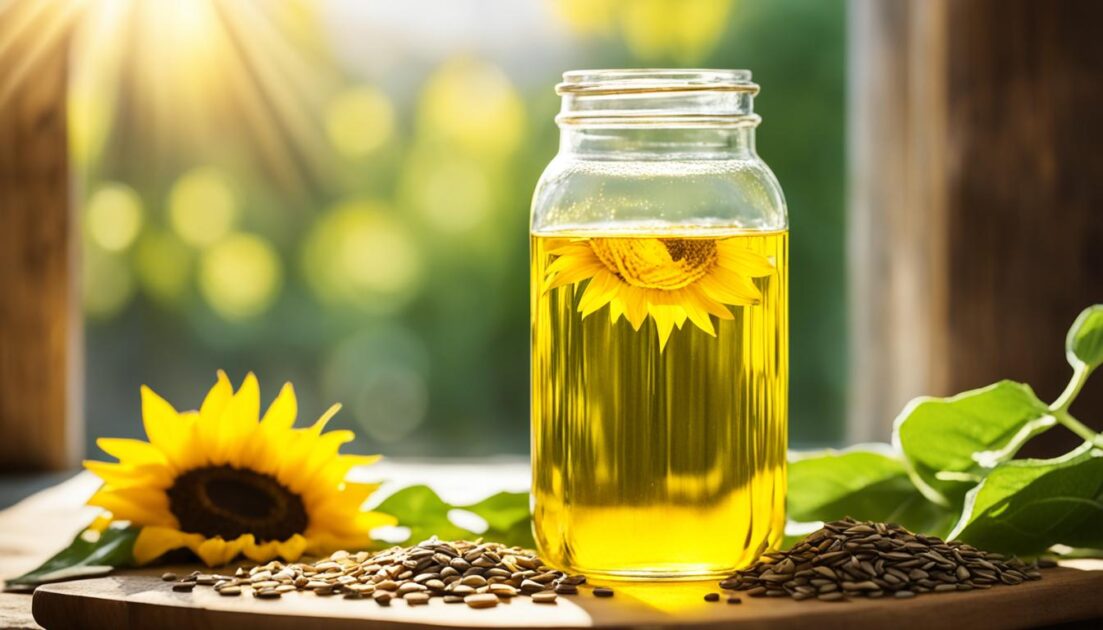Sunflower oil is a versatile and widely used vegetable oil that offers various benefits for both cooking and other applications. If you’re interested in learning how to make sunflower oil at home, you’ve come to the right place. In this step-by-step guide, I will take you through the entire production process, from seed selection to oil extraction and refining. By following these simple steps, you can create your own homemade sunflower oil and enjoy its goodness in your favorite recipes.
Key Takeaways:
- Homemade sunflower oil can be made by following a few basic steps at home.
- The production process includes seed selection, oil extraction methods, and refining.
- By making your own sunflower oil, you can enjoy its numerous benefits in your cooking.
- Homemade sunflower oil is free from additives and preservatives, ensuring a healthier option for your meals.
- Experiment with homemade sunflower oil in various recipes to enhance the flavor and nutritional value of your dishes.
The Journey of Sunflower Oil: From Field to Shelf
Sunflowers have a rich history and have been cultivated all over the world for their oil. Starting in North America, sunflowers have become a popular crop for oil production. Today, sunflower oil is used in cooking and for making margarine. It is also utilized in biodiesel production and as a high-protein animal feed. Sunflower oil has a mild flavor and a high smoke point, making it suitable for various culinary purposes.
Throughout history, sunflower oil has played a significant role in different cultures. Native Americans used sunflowers for both food and medicine, while European settlers brought sunflowers to Europe for decorative purposes. However, it wasn’t until the 18th century that sunflowers were recognized for their oil-bearing potential.
| Sunflower Oil History Timeline | |
|---|---|
| 1716 | Russian farmers begin cultivating sunflowers for oil production. |
| 1830s | Sunflowers arrive in North America through Russian immigrants, leading to commercial cultivation and oil production. |
| 1860s | Eastern European immigrants introduce sunflowers to the Great Plains in the United States. |
| 1900s | Modern sunflower hybrids are developed, leading to increased oil production and commercialization. |
Today, sunflower oil is produced through a combination of traditional and modern methods. The seeds are harvested from sunflower plants and then processed to extract the oil. Various extraction techniques are employed, including mechanical pressing and solvent extraction, to ensure maximum oil yield.
In addition to its culinary uses, sunflower oil offers numerous benefits. It is rich in vitamin E, an antioxidant that helps protect cells from damage. Sunflower oil is also a good source of unsaturated fats, which can help lower cholesterol levels when consumed as part of a healthy diet.
With its versatility, mild flavor, and health benefits, sunflower oil has established itself as an essential ingredient in many kitchens. Whether used for sautéing, baking, or salad dressings, sunflower oil adds a nutritious touch to a variety of dishes.

As the journey of sunflower oil continues, its mesmerizing golden hue and delightful aroma captivate and inspire culinary enthusiasts around the globe. From field to shelf, sunflower oil remains a shining star in the world of healthy cooking oils.
Seed Preparation: A Crucial Step in Sunflower Oil Extraction
Before extracting sunflower oil, the seeds must go through a preparation process. This entails carefully selecting high-quality oilseed varieties that have a higher oil content and thinner hulls. The selected seeds are then washed, dried, and dehulled to remove the outer layer, also known as the hull. This step is essential as it helps improve the overall efficiency of oil extraction and ensures a higher yield.
Proper oilseed selection is vital to maximize the oil content in the sunflower seeds. High-quality oilseeds with a higher oil content will result in a more productive oil extraction process. Additionally, thinner hulls make it easier to separate the hull from the seed during dehulling, reducing any potential losses of oil during this stage.
Once the oilseed selection is complete, the seeds are thoroughly washed to remove any impurities such as dust, dirt, or foreign particles. This step ensures that the extracted oil is of the highest quality and free from any contaminants.
After washing, the seeds are spread out to dry completely. It is essential to ensure that the seeds are completely dry before proceeding with the dehulling process. Any remaining moisture can affect the efficiency of the dehulling machines and lead to the loss of valuable oil.
Dehulling is the process of removing the outer layer or hull of the sunflower seeds. This can be done using specialized machines, such as hull and seed separators, which help separate the hull from the seeds. Dehulling is a crucial step in oil extraction as the hull contains minimal oil and can impede the extraction process if not removed.

The Benefits of Dehulling Sunflower Seeds:
Dehulling sunflower seeds offers several advantages:
- Improved oil extraction efficiency
- Reduced oil loss during extraction
- Higher oil yield
- Enhanced quality of the extracted oil
Dehulling Sunflower Seeds: Expert Recommendations
Leading agricultural experts recommend the following for dehulling sunflower seeds:
- Utilize specialized hull and seed separators for optimal results
- Minimize damage to the seeds during dehulling to prevent oil loss
- Regularly maintain and calibrate the dehulling equipment
- Implement quality control measures to ensure the removal of all hulls
- Conduct regular inspections and adjustments to maintain consistent efficiency
By paying attention to every detail in the seed preparation process, including oilseed selection, washing, drying, and dehulling, you can ensure a successful and efficient sunflower oil extraction process.
The Mechanical Extraction Process of Sunflower Oil
Mechanical extraction is a traditional and commonly used method for extracting sunflower oil. This process involves feeding the prepared sunflower seeds into an oil expeller machine, which applies pressure to remove a significant portion of the oil content.
The oil expeller machine, also known as a mechanical press, utilizes mechanical power to crush and compress the sunflower seeds, forcing the oil out. This mechanical extraction method is based on the principle of expeller pressing, where the seeds are subjected to continuous pressure and friction, resulting in the release of oil.
Throughout the mechanical extraction process, the oil expelled from the seeds is collected, while the remaining compressed oilseeds are referred to as oil cake. The oil cake still contains some oil and proceeds to the next step of the extraction process to recover the remaining oil content.
It is worth noting that mechanical extraction provides a high-quality sunflower oil with preserved nutritional value. This method does not involve the use of chemicals, ensuring a more natural and pure oil. However, compared to solvent extraction, mechanical extraction typically has a relatively lower oil yield.
To visually illustrate the mechanical extraction process, refer to the simplified diagram below:

| Mechanical Extraction Process of Sunflower Oil | |
|---|---|
| Step | Description |
| 1 | Selecting high-quality sunflower seeds |
| 2 | Preparing the seeds (washing, drying, dehulling) |
| 3 | Feeding the seeds into the oil expeller machine |
| 4 | Applying pressure to extract the oil |
| 5 | Collecting the expelled oil |
| 6 | Recovering the remaining oil from the compressed oilseeds (oil cake) |
Through the mechanical extraction process, a significant portion of sunflower oil is obtained. However, to maximize the oil yield, some producers may combine this method with solvent extraction, as discussed in the next section.
Solvent Extraction: Maximizing Oil Yield in Sunflower Oil Production
In order to maximize the oil yield and minimize waste, solvent extraction is often combined with mechanical extraction in the production of sunflower oil. Solvent extraction involves using a solvent, typically hexane, to extract the remaining oil from the oil cake.
The process begins by pouring hexane over the cake, resulting in an oil-solvent miscella and seed residue. The miscella, which contains a mixture of oil and solvent, is then separated from the residue. The solvent is evaporated, leaving behind the oil.
Desolventizing is the next step, in which the remaining hexane in the oil-solvent miscella is removed. This is typically done by heating the miscella under controlled conditions to evaporate the hexane, leaving behind the extracted oil.
The extracted oil is then sent for refining, where it undergoes further processes to improve its quality and shelf life. These refining processes include degumming, alkali neutralization, bleaching, dewaxing, and deodorization.
The remaining meal from the solvent extraction process, known as solvent extraction meal, is primarily used as high-protein animal feed. This helps minimize waste and maximize the use of sunflower seeds in the oil production process.
| Advantages of Solvent Extraction | Disadvantages of Solvent Extraction |
|---|---|
|
|
Oil Refining: Transforming Crude Sunflower Oil into a Consumer-Ready Product
Crude sunflower oil undergoes several refining processes to ensure it meets the quality standards for consumption. The oil refinery process is a crucial step that involves various techniques to refine and purify the oil, resulting in clear and high-quality sunflower oil ready for the market.
Degumming
Degumming is the first step in the oil refining process. During this stage, impurities such as phospholipids and other gums are removed from the crude oil. This is achieved by mixing the oil with water and heating it, causing the gums to separate and settle. The separated gums are then removed, leaving behind a clarified oil.
Alkali Neutralization
Alkali neutralization is the next step in the refining process. In this stage, the oil is mixed with an alkaline solution, usually sodium hydroxide, to neutralize any free fatty acids present in the crude oil. This process helps in reducing acidity, improving the oil’s taste, and enhancing its stability.
Bleaching
Bleaching is an essential step in the oil refining process as it helps remove unwanted impurities, such as pigments, waxes, and residual metals. The oil is treated with an adsorbent material, such as activated clay or activated carbon, which adsorbs these contaminants, resulting in a clearer and more visually appealing oil.
Dewaxing
Dewaxing is necessary to remove waxes from the sunflower oil, especially in colder climates where the oil may solidify. The oil is cooled and then filtered to remove any solidified waxes. This process improves the oil’s clarity and prevents cloudiness or turbidity when exposed to lower temperatures.
Deodorization
Deodorization is the final step in the oil refining process. During this stage, the oil is heated under high vacuum conditions, removing any volatile compounds that may contribute to undesirable flavors or odors in the oil. Deodorization enhances the oil’s taste and ensures it has a neutral aroma, making it suitable for various culinary applications.
By employing these refining techniques, crude sunflower oil goes through a comprehensive process that ensures it is transformed into a consumer-ready product. Each step, from degumming to deodorization, plays a crucial role in improving the quality, taste, and stability of the sunflower oil, resulting in a clear and high-quality oil that can be enjoyed in various culinary preparations.
Tips for Successful Sunflower Oil Production at Home
If you’re considering producing sunflower oil at home, it’s important to keep a few essential tips in mind to ensure a successful operation. Firstly, start by selecting high-quality oilseeds specifically intended for oil extraction. The quality of the oilseeds directly affects the final product, so be sure to choose ones that are fresh, undamaged, and have a high oil content.
Next, focus on equipment selection. Investing in the right equipment is crucial for safe and efficient oil extraction. Look for expeller presses and oil extractors that are specifically designed for sunflower oil production. It’s important to choose equipment made with durable materials and minimal wear and tear parts. This will not only reduce maintenance costs but also ensure the longevity of the equipment, allowing you to produce sunflower oil for years to come.
In addition to choosing the right equipment, regular maintenance is key to optimal production. Create a maintenance schedule and perform routine inspections to keep the equipment in good working condition. It’s also a good idea to have an annual maintenance contract with a professional technician to address any potential issues and ensure the equipment remains in top shape.
Lastly, the quality of the raw materials and the expertise of your workforce play a vital role in sunflower oil production. Ensure that the oilseeds you use are of the highest quality and sourced from reputable suppliers. Additionally, train your workforce on proper extraction techniques and emphasize the importance of attention to detail throughout the production process. By following these tips, you can achieve optimal results in sunflower oil production right in the comfort of your own home.
FAQ
How can I make sunflower oil at home?
To make sunflower oil at home, you can start by selecting high-quality oilseeds and following a step-by-step process, including seed preparation, extraction methods, and refining. By using the right equipment and ensuring the quality of your raw materials, you can create homemade sunflower oil for use in your kitchen.
What are the benefits of sunflower oil?
Sunflower oil offers numerous benefits. It has a mild flavor, a high smoke point, and is rich in vitamin E. It is also versatile and can be used for cooking, making margarine, biodiesel production, and as animal feed due to its high protein content.
What is the history of sunflower oil?
Sunflowers have a rich history and have been cultivated worldwide for their oil. Originating in North America, sunflowers have become a popular crop for oil production. Today, sunflower oil is widely used in various applications, including cooking and food preparation.
How do you extract sunflower oil?
Sunflower oil can be extracted using mechanical extraction or a combination of mechanical and solvent extraction. Mechanical extraction involves pressing the prepared sunflower seeds in an oil expeller machine, while solvent extraction involves using a solvent, typically hexane, to extract the remaining oil from the oil cake.
What is the refining process for sunflower oil?
The refining process for sunflower oil includes several steps, such as degumming, alkali neutralization, bleaching, dewaxing, deodorization, and optional winterization. These steps help remove impurities, reduce acidity, and improve the clarity and stability of the oil.
What equipment do I need for making sunflower oil at home?
To make sunflower oil at home, you will need equipment such as expeller presses, oil extractors, and hull and seed separators. It is crucial to select durable equipment made from high-quality materials to ensure safe and efficient oil extraction. Regular maintenance and an annual maintenance contract are also recommended.
Where can I find high-quality oilseeds for sunflower oil production at home?
You can find high-quality oilseeds for sunflower oil production at home from reputable suppliers, agricultural stores, or online marketplaces. Look for oilseeds specifically intended for oil extraction and ensure their quality by checking for viable seed viability and oil content.






